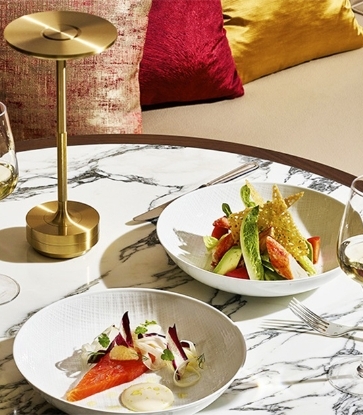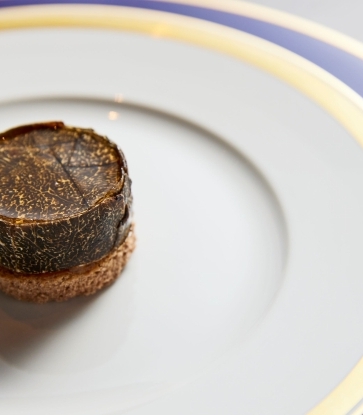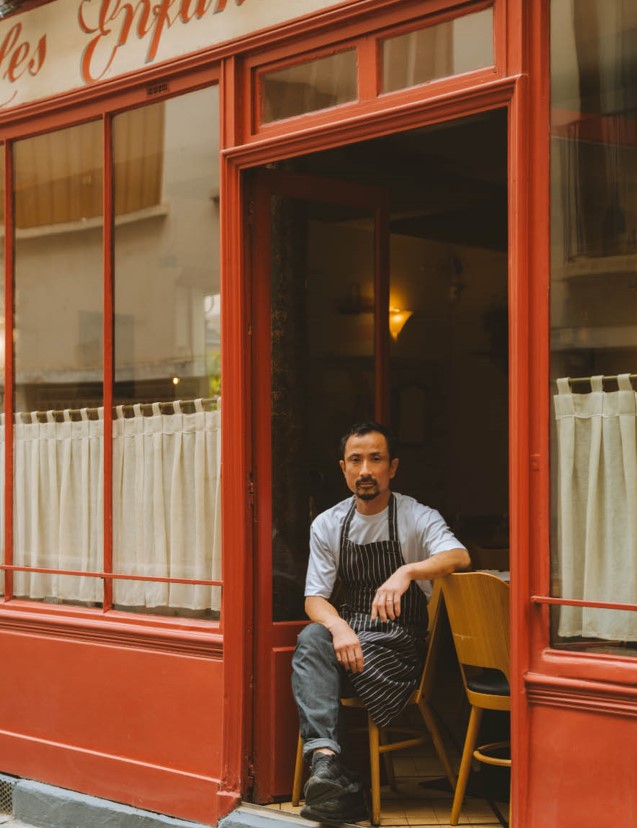‘Good morning! ‘Thank you for coming here today.’ It’s 8 AM at the Metropolitan Central Wholesale Market, better known as Toyosu Market. Though early-morning transactions have abated for now, turret trucks (forklifts for narrow spaces) scurry restlessly to and fro. Amid this bustle, Osamu Matsuura, owner-chef of Sushi Matsuura, a One MICHELIN Star sushi restaurant, joins us.


Matsuura's entry into the world of sushi began at a surprising place. Dreaming of becoming a pro skateboarder, he moved to Tokyo. To secure time for skateboarding practice, he took a job at a fishmonger. Curiosity about the fate of the fish brought daily into the shop stoked his interest, and Matsuura made the leap into the world of sushi. After apprenticing at sushi restaurants in the capital, in 2019 Matsuura opened a restaurant in the Shirokane area of Tokyo with the concept of ‘eat and drink a ¥30,000 value for ¥20,000’. His vision was to make old-school Edo-style sushi a part of daily life rather than a rare and special treat. Pursuing his dream of providing this lifestyle, Matsuura has now been operating his sushi shop for three years.
Buying fish at Toyosu Market every morning and returning with it to the restaurant is a part of Matsuura’s daily routine. Hot or cold, rain or wind, Matsuura rides his motorcycle to Toyosu, and for good reason.
Toyosu Market, Japan's Largest Fish Market
In 2021, 330,000 t* of marine products were traded at Toyosu Market, with value of 3.8 trillion yen*. As one of the world’s largest markets, Toyosu Market receives top-class marine products from every corner of Japan.Though its move from Tsukiji to Toyosu in 2018 is still fresh in the memory, Toyosu Market traces its history back to circa 1644, during the Edo period. Its original location was Nihonbashi, designated by the Tokugawa Shogunate as the very centre of Edo (Tokyo). The fish market was born there when fishermen, after surrendering part of their catch as taxes to the shogunate, began selling their remaining catch there.

Fast-forward to 1923 and the Nihonbashi fish market was destroyed in the Great Kanto Earthquake of that year. After a temporary relocation, Tsukiji Market opened in 1935, with the Metropolitan Central Wholesale Market as its main component. For decades thereafter, it is no exaggeration to say that Tsukiji Market played the role of ‘Japan’s kitchen’. Over time, the space became decrepit and cramped, and as the times changed, demand rose for more environmentally friendly facilities. Thus, the 83-year history of Tsukiji drew to a close, and the story of Toyosu began.

Links to Brokers
These days it isn’t necessary to visit the market in person. Telephone orders, deliveries, and other methods of procuring fish are available, and the pandemic has only accelerated their adoption. Even so, Matsuura makes the daily journey without fail, because he prizes his relationships with the market’s brokers.Many of Matsuura’s suppliers are shops he’s frequented since his apprentice days. Matsuura recalls that when he was working hard toward his goal of becoming a sushi chef, one day a broker gave him a conger eel, saying, ‘Use this to practice your eel filleting’. Another broker once took him to an auction as a learning experience. Whenever he didn’t understand something or didn’t know what to do, a broker would introduce him to another brokerage or otherwise assist him. He often received help from those around him in this way, Matsuura remembers.
‘I’ve known some of these brokers since I was about 18’, Matsuura reflects. ‘They were all older than me, so they kind of took me under their wing. Wonderful people, every one of them’, says Matsuura with a smile.

How Kohada Became a Sushi Topping
It’s 8 AM and Matsuura has arrived at Toyosu Market. Recently a lot of people have been coming at 7:30 to 8 o’clock to make their purchases, he says, because most are just picking up orders placed in advance. The system works well because brokers needn’t worry about unsold stock, while buyers can get the fish they want without arriving early. It’s a glimpse of Toyosu Market today, diversifying to serve the needs of the era. After spending about 40 minutes in the market, Matsuura mounts his motorcycle and hurries back to Shirokane.
As soon as he arrives at the restaurant, Matsuura begins preparing the ingredients. Matsuura runs the kitchen by himself, so efficiency and economy of movement are key. First, the kohada must be rinsed. Next he trims the fish, removing scales, head, and entrails with eye-popping speed. We gaze in fascination at Matsuura’s deft handiwork. Every few minutes, a timer goes off, prompting the chef to check on the kanpyo (strips of dried gourd) he’s simmering. When the phone rings, he answers that, too. Not matter how busy he gets, Matsuura moves with practiced efficiency.
After rinsing, the chef opens up the fish and salts it. He uses a great deal of salt, but to prevent it from getting too salty he then removes some by soaking the fish in water.

‘I’m not a big fan of vinegary flavours’, says Matsuura, explaining why his kohada is so mild. He took the method he learned as an apprentice and tweaked it to his own preference, he says, in pursuit of his own ideals in sushi. To ensure affinity between the kohada and the rice, he uses the same vinegar as in his vinegared rice, marinating the fish only briefly. Carefully examining each individual piece, Matsuura adjusts the times the fish is marinated and aged according to how oily or fatty the fish is.

The timer rings again and again. ‘I set them at just the right time’, says Matsuura, retrieving the kohada from the vinegar and arraying it on bamboo baskets. The kohada will later be aged for two to three days, depending on size, or even four or five days for the largest pieces. These painstakingly-sourced toppings will finally be mated with vinegared rice when it is time to place them in front of the customer.

‘This is how I cheer my customers on’
What’s most important when forming sushi by hand, says Matsuura, is the feeling you put into it. He moulds his sushi with the earnest wish that it will give his diners the vitality they will need the following day. The fisherman who catches the fish, the driver of the truck that transports it, the broker in the market—all are members of a team, and the anchor of that relay is the chef. Each piece of sushi that master craftsman Matsuura forms carries the spirit and aspirations of the entire team.
Related:
*Source: Tokyo Metropolitan Central Wholesale Market Market Statistics (Annual Report) Summary Table

















